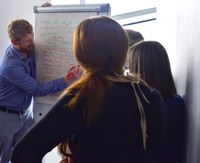UKEOF at the Natural Capital Initiative conference
Members of UKEOF's Natural capital working group (NCWG) attended the Valuing our Life Support Systems Natural Capital Initiative conference at the Crystal in London in May, where they hosted a session on ‘Advancing and Integrating methods for natural capital monitoring and assessment in the UK’.
Lisa Norton opened proceedings with an introduction to the UKEOF NCWG and was followed by a series of talks from bodies using natural capital monitoring information. Jane Lusardi presented Natural England’s Natural Capital Indicators project, which seeks to identify the ideal indicators for measuring changes in Natural Capital using detailed logic chains. Tom McKenna followed by describing the Natural Capital Asset Index, a national indicator that tracks the potential of Scotland’s habitats to contribute to human wellbeing, through a wide range of indicators.
Adam Dutton from the Office for National Statistics discussed some of the challenges in creating national natural capital accounts, including; data availability and reliability, granularity of data and social and market forces which result in complexity requiring detailed interpretation. Finally, Russell Elliott gave a Welsh perspective on the sustainable management of natural resources and how this is measured in Wales, through the prisms of ecosystem resilience and human wellbeing.
The second half of the session consisted of a workshop in which participants were split into four groups and were asked to answer the following questions.
- What do we do well in terms of UK/country level monitoring?
Land-cover and OS maps, water quality, remote sensing and biological records all scored quite highly. - What are the key priority gaps in monitoring at country/UK scales?
Understanding the quality and condition of our natural assets was seen as key, with participants also identifying a need for better links to actual service provision, benefits and demands. Standardisation of approaches was also a popular response, as was a suggestion to form a single body to pull all this data together. Soil, agri-environment and net environmental gain and funding were also highlighted. - Where are the opportunities for improving natural capital monitoring (all scales)?
A huge range of opportunities for improving natural capital monitoring in the future was envisaged. The two most popular concerned citizen science and technology (and the potential to link the two e.g. via phone apps). A national repository for datasets was also suggested. Integration of social scientists and cultural organisations with environmental scientists was highlighted as a potential opportunity. Increased interest in the environment from the general public, businesses and governments were seen as potentially providing an opportunity for increased funding. - What are the key threats to UK level monitoring (and why do they matter?)
By far the strongest level of agreement across the four questions was on this perceived threat – resources and funding was the most popular response with some emphasis on the continuity of monitoring. The lack of common baselines was also identified as an issue. Skill shortages could create problems for future monitoring. Changing priorities from the general public and poor engagement of governments were also highlighted as being key threats to UK natural capital monitoring. Uncertainty surrounding Brexit and access to data were also discussed.
Further information
- Valuing our Life Support Systems 2019, conference website
- UKEOF Natural Capital Working Group
- UKEOF leaflet: Underpinning UK Natural Capital Approaches
- Lusardi, J., et al., 2018. Natural Capital Indicators: for defining and measuring change in natural capital. Natural England Research Report, Number 076
- Scottish Natural Heritage, 2018. Natural Capital Asset Index
- Natural Resources Wales. 2016. State of Natural Resources Report (SoNaRR): Assessment of the Sustainable Management of Natural Resources. Technical Report
[Photo: Matt Harwood, Royal Society of Biology]

